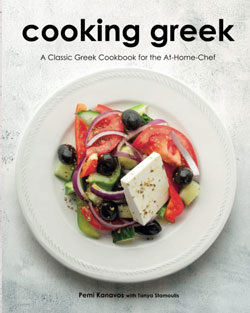Menu
Install the app
How to install the app on iOS
Follow along with the video below to see how to install our site as a web app on your home screen.
Note: This feature may not be available in some browsers.
You are using an out of date browser. It may not display this or other websites correctly.
You should upgrade or use an alternative browser.
You should upgrade or use an alternative browser.
Greek Food, Cooking and Recipe Community
Is Greek rice pudding different from any other countries rice pudding?
- Thread starter acamp7
- Start date
1 - 5 of 5 Posts
Great question! I have only had Greek rice pudding, so I am not sure and look forward to other replying on this one 
Every country seems to put its own touches on one of the World’s favorite comfort foods….rice pudding. The major differences are: the type of rice used (or available), the method of cooking (stove top or baked), the binding ingredient (milk, eggs, cornstarch etc.) and perhaps most important, the seasonings and accompaniments used. For example I’ve made a Lebanese rice pudding with rose water and almonds. An Indian pudding might contain cardamom and raisins; an Italian pudding could even contain coffee and chocolate! While most rice pudding recipes are very similar to the Greek in their use of cinnamon, what surprised me most about the Greek version was that it was often served in the villages warm for breakfast….like waiting for the fresh donuts!! 
Great point!! What type of rice do you recommend? And what type of rice do Greeks use?Every country seems to put its own touches on one of the World’s favorite comfort foods….rice pudding. The major differences are: the type of rice used (or available), the method of cooking (stove top or baked), the binding ingredient (milk, eggs, cornstarch etc.) and perhaps most important, the seasonings and accompaniments used. For example I’ve made a Lebanese rice pudding with rose water and almonds. An Indian pudding might contain cardamom and raisins; an Italian pudding could even contain coffee and chocolate! While most rice pudding recipes are very similar to the Greek in their use of cinnamon, what surprised me most about the Greek version was that it was often served in the villages warm for breakfast….like waiting for the fresh donuts!!
k_tsoukalas
Administrator
The Greek version is pretty simple. Usually rice, milk, honey or sugar, cinnamon. I have seen recipes with orange peel, maybe some mahleb or vanilla. Other countries have similarities, some even do it the same way. Some versions use other types of milk, like coconut milk (I think I saw that in a Thai restaurant). The nice thing about this dish is that it is pretty versatile.
1 - 5 of 5 Posts
JOIN THE DISCUSSION AND READ OTHER GREEK INFO:
Stuffed grape leaves - how much filling?
- voula_slat
- Greek Food Forum
- Replies: 1
I haven't made stuffed grape leaves in a while and I have some questions.
First of all, I am having a hard time judging how much filling to put in each leaf? I have a friend who helped me and tried to explain. She'd put a teaspoon of filling in the leaf, then add or subtract more after looking at it. She's quick rolling, and I have no idea how she knows how much filling.
And she really couldn't explain it - just said that you have to look at it and it's by feel. It sounds like my yiayia and she's younger than me! I told her that and she just shrugged. She tried to talk me through it as we were rolling together but it seemed so random to me.
First of all, I am having a hard time judging how much filling to put in each leaf? I have a friend who helped me and tried to explain. She'd put a teaspoon of filling in the leaf, then add or subtract more after looking at it. She's quick rolling, and I have no idea how she knows how much filling.
And she really couldn't explain it - just said that you have to look at it and it's by feel. It sounds like my yiayia and she's younger than me! I told her that and she just shrugged. She tried to talk me through it as we were rolling together but it seemed so random to me.
Roundup of Easy Recipes to Start Cooking Greek Food
- mastichas09
- Greek Food Forum
- Replies: 3
I know a lot of people who want to start cooking Greek food but are intimidated. I want to help them out by brainstorming a list of "easy win" foods to get started making.
Here's what I have - do you have anything to add?
Here's what I have - do you have anything to add?
- Greek Village Salad (Horiatiki)
- Tzatziki
- Greek Lemon Chicken
- Greek Lemon Potatoes
- Souvlaki
- Greek yogurt with honey and walnuts
- Grilled Halloumi cheese
- Fasolakia
- Briam
- Greek style lamb chops
Current food trends in Greece?
- dpappas87
- Greek Food Forum
- Replies: 0
I understand that Greece is just like other countries where there might be food trends, new dishes, etc to enjoy.
I'm looking to understand more about the latest trends that are currently shaping it. I'm particularly interested in how traditional Greek recipes are being reimagined by modern chefs, how regional variations are gaining popularity, or if there's a rise in any particular ingredients or cooking methods.
Is anyone here keeping tabs on contemporary movements in Greek food? Maybe you've dined at a restaurant that surprised you with a modern twist on a Greek classic, or you've come across new food blogs with innovative recipes.
The cuisine of Greece is as much about the traditional recipes we all love as it is the trends and the way the cuisine moves forward!
I'm looking to understand more about the latest trends that are currently shaping it. I'm particularly interested in how traditional Greek recipes are being reimagined by modern chefs, how regional variations are gaining popularity, or if there's a rise in any particular ingredients or cooking methods.
Is anyone here keeping tabs on contemporary movements in Greek food? Maybe you've dined at a restaurant that surprised you with a modern twist on a Greek classic, or you've come across new food blogs with innovative recipes.
The cuisine of Greece is as much about the traditional recipes we all love as it is the trends and the way the cuisine moves forward!
Mediterranean Diet Tied to Lower Blood Pressure, Greek Study Shows!
- Hash
- Greek Food Forum
- Replies: 0
I drink a large tablespoon of pure Virgin Olive oil (0.3% acidity) whenever I remember!
https://greekreporter.com/2024/04/1...+to+Lower+Blood+Pressure_2C+Greek+Study+Shows
https://greekreporter.com/2024/04/1...+to+Lower+Blood+Pressure_2C+Greek+Study+Shows
How to learn about different regional cuisines in Greece?
- toniiv
- Greek Food Forum
- Replies: 0
I have learned so much about Greek cuisine by being on this forum! I know that there are standard recipes that everyone seems to cook.
For example, you can get souvlaki all over. Everyone seems to serve a village salad with slight variations. Most regions seem to make moussaka. There are tons of others.
I have also noticed that each region has their own specialties. How do you go about learning about them?

For example, you can get souvlaki all over. Everyone seems to serve a village salad with slight variations. Most regions seem to make moussaka. There are tons of others.
I have also noticed that each region has their own specialties. How do you go about learning about them?

Sign up for a free account and share your thoughts, photos, questions about Greek food, travel and culture!
WorldwideGreeks.com is a free online forum community where people can discuss Greek food, travel, traditions, history and mythology.
Join Worldwide Greeks here!
Join Worldwide Greeks here!
JOIN COMMUNITY FOR FREE
LOGIN TO YOUR ACCOUNT



